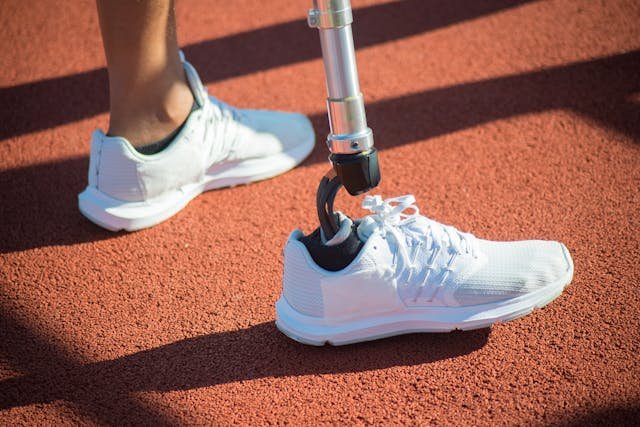Getting dressed should be easy, fun, and comfortable for every child, including those using prosthetic limbs. But sometimes, regular shoes and clothing don’t work well with prosthetics. A shoe might be too tight to fit over a prosthetic foot, or a pair of pants might not allow easy movement for a prosthetic leg. For children with upper-limb prosthetics, fastening buttons or tying shoelaces can also be frustrating and time-consuming.
The good news is that prosthetic-friendly shoes and clothing are now easier to find. Many brands have started designing adaptive footwear and clothing that make dressing easier, while parents can also modify regular clothes and shoes to improve comfort and function.
At Robobionics, we believe that children should feel comfortable and confident in whatever they wear. This guide will help parents choose the best prosthetic-friendly shoes and clothing that make daily dressing stress-free, functional, and fun.
Choosing the Right Shoes for Kids with Prosthetic Limbs
Shoes play a major role in comfort, balance, and movement for children with prosthetic legs. The right pair should provide stability, adjustability, and ease of use.
Lightweight and Flexible Shoes for Natural Movement

Children with prosthetic legs need shoes that are light and flexible. Heavy or stiff shoes can make walking more tiring and uncomfortable, especially if the prosthetic limb doesn’t move the same way a natural foot does.
Shoes made with light materials like mesh or soft leather allow for easier movement and better airflow, keeping the foot cool and comfortable. A soft, flexible sole also helps with natural foot motion, making each step feel smoother and more balanced.
For active kids, sports shoes with good cushioning reduce impact and prevent unnecessary strain on the prosthetic limb. Shoes with shock-absorbing soles are ideal for running, jumping, and playing.
Adjustable Shoes for a Secure Fit
Prosthetic feet often have a fixed shape and size, so finding shoes that fit well can be challenging. Shoes with adjustable features like Velcro straps, elastic laces, or wide openings make it easier to put on and remove shoes, especially for children who prefer dressing independently.
Wide-fit shoes provide extra space, allowing the prosthetic foot to slide in without forcing or stretching the shoe. Some shoes also come with removable insoles, which create more room inside when needed.
For children who wear prosthetic legs with energy-return feet, shoes should have a snug but comfortable fit, ensuring that they stay secure during movement.
Zipper or Split-Opening Shoes for Easy Wear
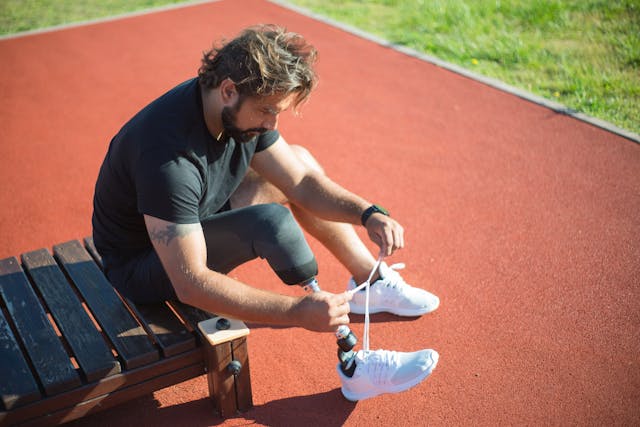
Some brands now offer adaptive shoes with zippers along the sides or back, making them extremely easy to wear. Instead of struggling to push a prosthetic foot into a regular shoe, these designs allow the shoe to open wide, so the foot can slide in effortlessly.
Shoes with split openings or fully detachable uppers provide even more convenience. These are especially helpful for kids with limited mobility or those who use only one hand to put on their shoes.
Brands like Nike FlyEase and Billy Footwear offer stylish, adaptive shoe options that are both comfortable and easy to wear. Parents can also modify regular shoes by cutting slits along the sides and adding Velcro or zippers, making them more prosthetic-friendly.
Finding the Right Clothing for Kids with Prosthetic Limbs
Clothing should be comfortable, easy to put on, and allow free movement. Kids with prosthetic limbs may struggle with tight sleeves, stiff pants, or clothing that doesn’t stretch properly. Choosing the right designs makes a huge difference in how easily they can dress and move throughout the day.
Stretchable and Loose-Fitting Clothing for Easy Movement
Fitted clothing can restrict movement and make it difficult for children to adjust or use their prosthetic limb comfortably. Stretchable fabrics like cotton blends, spandex, or jersey knit allow for better flexibility and ensure that the prosthetic limb moves freely.
Loose-fitting pants and shirts with elastic waistbands or adjustable cuffs make dressing easier. Wide sleeves and pant legs prevent tightness, making it simpler to slide a prosthetic limb through. Clothing with side slits or zippers along the seams also provides extra room when needed.
For active children, athletic wear with moisture-wicking fabric keeps them cool and comfortable throughout the day. Soft seams and tag-free designs reduce skin irritation, making clothing gentle and comfortable on the skin.
Magnetic or Velcro Closures for Independent Dressing
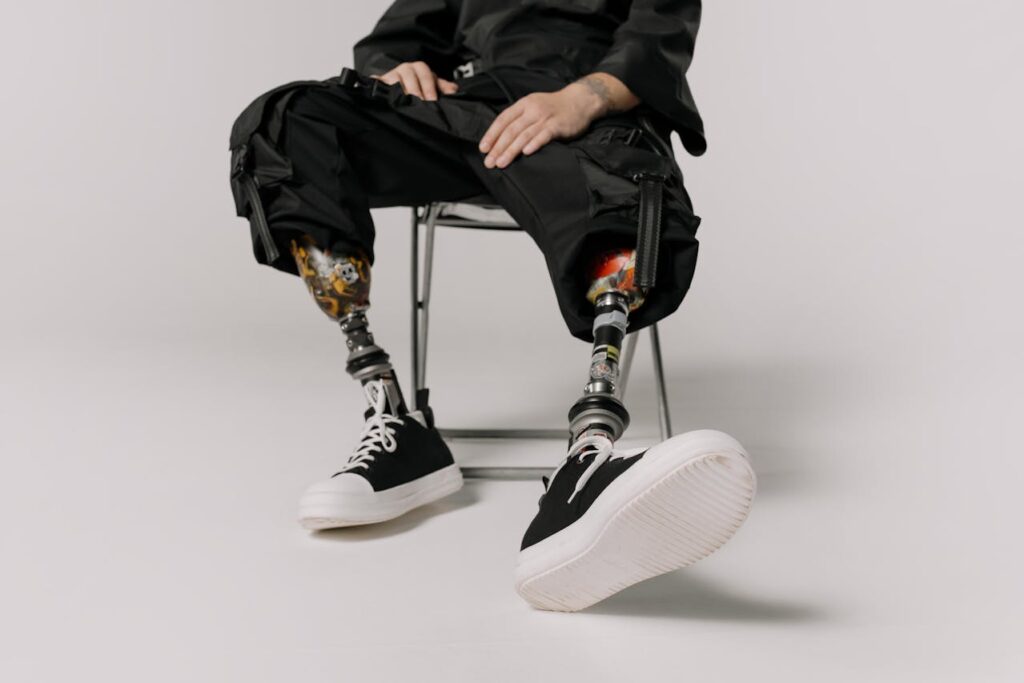
Buttons, zippers, and shoelaces can be tricky to manage with a prosthetic hand or one functional hand. Adaptive clothing with magnetic closures, Velcro fastenings, or pull-on designs makes independent dressing much easier.
Many brands now offer button-up shirts with hidden magnets, making them look stylish while being super easy to wear. Pants and jackets with Velcro closures instead of zippers allow children to dress quickly without assistance.
Some parents modify regular clothing by replacing small buttons with larger ones, adding loops to zippers, or sewing Velcro over traditional fasteners. These small changes help children dress independently without frustration.
Flat Seams and Soft Fabrics for Comfort
Some prosthetic limbs have hard edges or straps that can rub against clothing, causing wear and tear over time. Choosing clothing with flat seams and reinforced stitching prevents fabric from wearing out too quickly.
Soft fabrics like bamboo, modal, or fleece are gentle on the skin and prevent irritation caused by friction between the prosthetic and the fabric. Avoiding clothing with scratchy tags or rough seams makes daily wear more comfortable.
For children who experience skin sensitivity or chafing, wearing a thin, breathable layer under their clothes (such as a compression sleeve or soft leggings) helps protect their skin while keeping them cool and comfortable.
Modifying Regular Clothes and Shoes for a Better Fit
Parents don’t always have to buy special adaptive clothing—they can modify regular clothes to make them more prosthetic-friendly.
Altering Pants for Prosthetic Legs
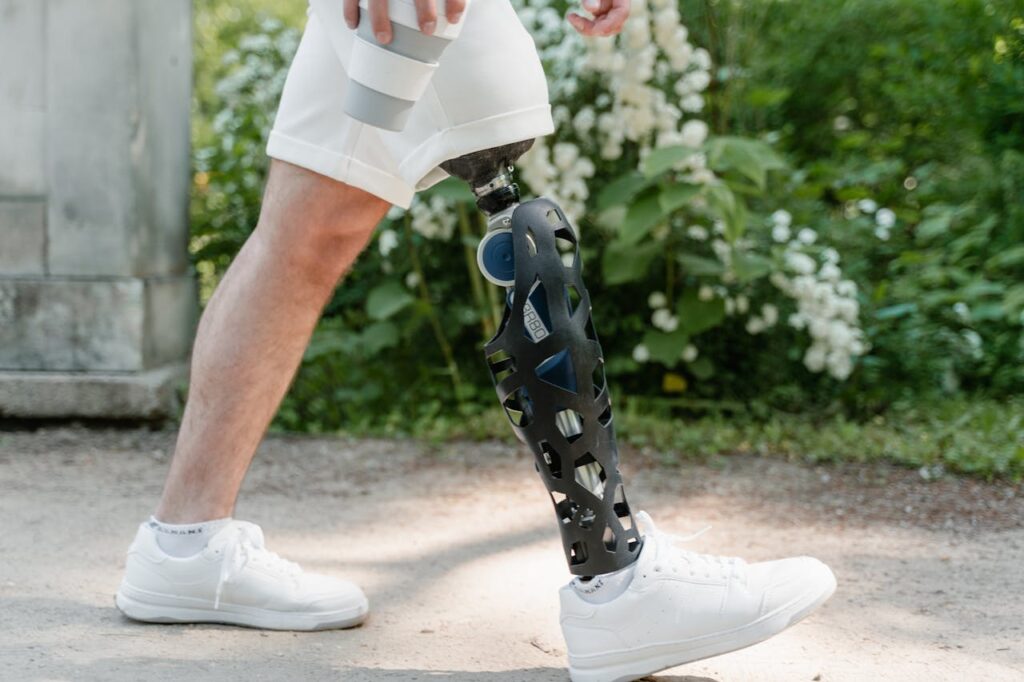
If a child’s prosthetic leg sticks out under their pants or feels too tight, parents can:
- Sew a small side zipper or Velcro strip along the pant leg to make dressing easier.
- Use pants with reinforced knee patches to prevent wear and tear from the prosthetic.
- Choose pants with extra-wide legs or stretchy materials for better mobility.
Adjusting Sleeves for Upper-Limb Prosthetics
Long sleeves can sometimes be tricky to wear over an upper-limb prosthetic. Parents can:
- Cut small slits along the wrist area to allow more flexibility.
- Use shirts with wide or rolled-up sleeves to prevent tightness.
- Replace buttoned cuffs with elastic bands or Velcro fastenings for easier wear.
Making Shoes Easier to Wear
If a child’s prosthetic foot doesn’t fit well in a shoe, parents can:
- Remove the insole to create more space inside.
- Cut a small slit in the back of the shoe and add a zipper for easy entry.
- Use elastic shoelaces or Velcro straps for quick fastening.
The Role of Fashion in Building Confidence
The clothes and shoes children wear play a big role in how they see themselves and interact with others. When kids feel comfortable and stylish in their outfits, they feel more confident and ready to take on the world.
Giving Kids a Say in Their Clothing Choices

Allowing children to choose their own outfits—even if they need some guidance—helps them feel in control of their dressing routine. They may prefer certain colors, fabrics, or designs that make them feel more comfortable.
For example, if a child prefers baggy clothes over tight-fitting ones because they find them easier to put on, it’s good to respect that choice. Encouraging self-expression through fashion helps them develop a sense of independence and identity.
Helping Kids Feel Included in Fashion Trends
Many kids want to wear clothes that look like what their friends are wearing. Fortunately, more brands are now making adaptive clothing and shoes that look just as stylish as regular fashion.
Brands like Tommy Hilfiger Adaptive, Nike FlyEase, and Billy Footwear offer trendy designs that are also easy to wear with prosthetic limbs. Choosing these styles helps children feel included in fashion trends while still having clothing that meets their specific needs.
Making Dressing Up an Exciting Experience
For children who may find dressing up frustrating at times, turning it into a fun and engaging activity can change their perspective. Encouraging creative outfit choices, accessorizing with fun items, or letting them pick their favorite shoes helps build excitement around getting dressed.
Letting kids personalize their prosthetic limb with colors, stickers, or custom designs can also help them feel more connected to their look. When dressing becomes an enjoyable routine rather than a struggle, kids feel more positive about their independence.
Adapting Seasonal Clothing for Maximum Comfort
Each season comes with different dressing challenges. Whether it’s keeping cool in summer, staying warm in winter, or adjusting to rainy weather, having the right clothing and shoes makes all the difference.
Summer Clothing: Staying Cool and Comfortable
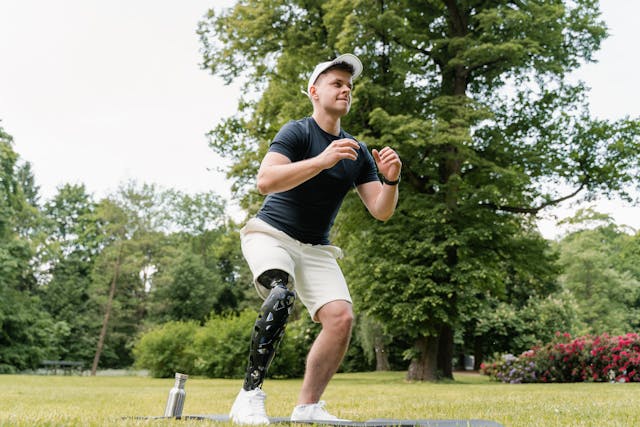
During hot weather, children with prosthetic limbs may experience heat buildup and sweating, especially around the prosthetic socket. Choosing breathable, moisture-wicking fabrics like cotton or bamboo can help keep the skin cool and prevent irritation.
Light, loose-fitting clothes allow for better air circulation, reducing sweat buildup. For children with prosthetic legs, wearing shorts or cropped pants may feel more comfortable than long pants. Some kids may prefer arm sleeves or leg covers that protect against direct sun exposure without overheating.
Sandals or lightweight sneakers with adjustable straps can help keep feet cool while still providing the necessary support for prosthetic feet.
Winter Clothing: Ensuring Warmth Without Bulk
Cold weather can make prosthetic limbs feel colder than natural limbs, and wearing too many thick layers can make movement difficult. Layering with thin, thermal materials like fleece or wool helps keep kids warm without restricting mobility.
For kids with prosthetic legs, pants with elastic cuffs or zippered sides allow for easy dressing over the prosthetic. Jackets with side zippers, magnetic closures, or wide sleeves make it easier for kids with upper-limb prosthetics to put on winter wear independently.
For footwear, waterproof boots with adjustable openings provide warmth and stability without making movement difficult. Some children may benefit from heated socks or liners if their prosthetic foot tends to feel cold in winter.
Rainy Season: Waterproof and Slip-Resistant Wear
Rainy weather can make surfaces slippery, which can be challenging for kids using prosthetic legs. Waterproof shoes with non-slip soles ensure better grip and safety while walking on wet surfaces.
Raincoats with wide armholes and magnetic closures make it easier for kids with upper-limb prosthetics to wear layers without difficulty. Quick-drying fabrics and water-resistant pants help prevent clothing from becoming too heavy or uncomfortable in wet conditions.
Making School Dressing Easier with Prosthetic-Friendly Uniforms
For children who wear school uniforms, modifying standard designs can make daily dressing much easier.
School Shoes That Work with Prosthetics
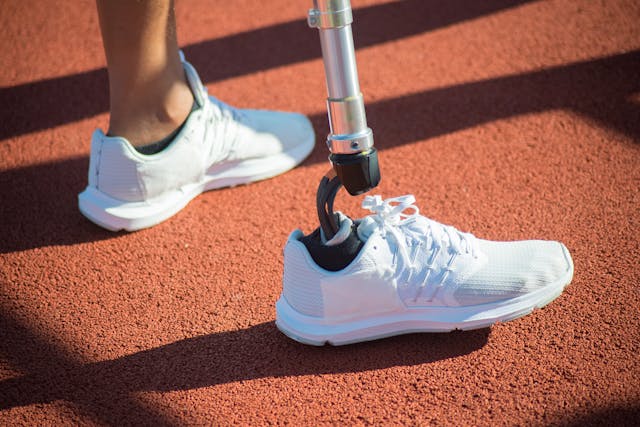
Many schools require black leather shoes or specific footwear styles. If these shoes are difficult to wear over a prosthetic foot, parents can:
- Look for school-approved shoes with Velcro or zippers instead of laces.
- Choose wider-fit school shoes that make slipping the prosthetic foot in easier.
- Ask the school if adaptations are allowed, such as sports-style black sneakers instead of formal leather shoes for added comfort.
Modifying School Uniforms for Easy Wear
If school uniforms have tight sleeves, stiff collars, or difficult buttons, they can be modified by:
- Using magnetic buttons instead of regular buttons on shirts and jackets.
- Choosing elastic-waist pants or skirts instead of those with zippers or buttons.
- Replacing difficult fasteners with Velcro or hidden zippers to allow easier dressing.
Encouraging Schools to Support Adaptive Wear
Some schools are open to allowing small uniform modifications if it helps a child with a prosthetic limb dress more easily. Parents can talk to school administrators about reasonable changes that make uniforms more accessible without affecting dress code policies.
Schools should also be aware of adaptive needs during activities like sports days, swimming lessons, and school trips, ensuring that children with prosthetics feel included and comfortable.
Final Thoughts: Dressing for Comfort, Confidence, and Independence
Finding the right prosthetic-friendly shoes and clothing helps children feel comfortable, confident, and independent in their daily lives. The goal is to choose clothes that are easy to wear, shoes that fit well, and fabrics that feel good—allowing kids to move freely without frustration.
At Robobionics, we believe that children should never feel limited by their prosthetic limb. Whether it’s modifying regular clothes, finding the right footwear, or choosing adaptive designs, parents can help their child feel empowered and stylish in whatever they wear.
🚀 Looking for expert guidance on prosthetic-friendly solutions? Book a free consultation with our team today!
💡 Need advice on prosthetic care and daily comfort? Contact us now, and let’s help your child dress with ease and confidence!



